Advertisement |
 |
Do you have a career question?
The Naturejobs podcast features one-on-one Q&As, panel discussions and other exclusive content to help scientists with their careers. Hosted on the Naturejobs blog, the podcast is also available on iTunes and Soundcloud.
Listen today! |  | | |
 |
 |
TABLE OF CONTENTS
|
| May 2018 Volume 10, Issue 5 |
 |  |  |
 |  Thesis Thesis
 News & Views News & Views
 Articles Articles
 Amendments & Corrections Amendments & Corrections
 In Your Element In Your Element
| |
| Advertisement |
 |
KACST Impact
KACST Impact is a new online publication highlighting the latest cutting edge scientific research conducted at King Abdulaziz City for Science and Technology (KACST) that features various stories ranging from exciting new scientific finds to the commercialization of innovative discoveries.
Learn more » |  | | |
 |
| |
Thesis | |
 |
 |
 |
| Tweaking mechanosensors pp483 - 484
Bruce C. Gibb
doi:10.1038/s41557-018-0051-6 |
 |
News & Views | |
 |
| |
Articles | |
 |
 |
 |
| Single-cell mRNA cytometry via sequence-specific nanoparticle clustering and trapping pp489 - 495
Mahmoud Labib, Reza M. Mohamadi, Mahla Poudineh, Sharif U. Ahmed, Ivaylo Ivanov et al.
doi:10.1038/s41557-018-0025-8
Cell-to-cell variation in gene expression creates a need for techniques that characterize expression at the level of individual cells. Now, a technique for characterizing mRNA expression has been developed. The technique uses the intracellular self-assembly of magnetic nanoparticles to quantitate RNA levels at the single-cell level. 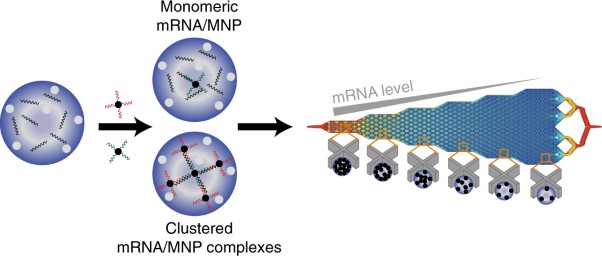 |
 |
 |
 |
| Genetically encoded lipid–polypeptide hybrid biomaterials that exhibit temperature-triggered hierarchical self-assembly pp496 - 505
Davoud Mozhdehi, Kelli M. Luginbuhl, Joseph R. Simon, Michael Dzuricky, Rüdiger Berger et al.
doi:10.1038/s41557-018-0005-z
Inspired by the post-translational modifications of polypeptides widespread in biological systems, the one-pot synthesis of biohybrid materials was engineered within Escherichia coli using a recombinant expression and post-translational lipidation. The fatty-acid-modified elastin-like polypeptides (FAMEs) prepared, which comprise peptide-amphiphile segments prone to self-assembly fused to a thermally responsive elastin-like polypeptide, exhibit temperature-triggered hierarchical assembly. 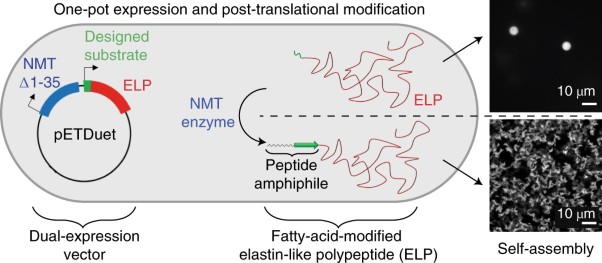 |
 |
 |
 |
| Control over phase separation and nucleation using a laser-tweezing potential pp506 - 510
Finlay Walton & Klaas Wynne
doi:10.1038/s41557-018-0009-8
A low-power laser can cause phase separation or trigger the nucleation of a new phase in the proximity of a liquid–liquid critical point, or binodal, using a laser tweezing potential. This effect explains the physics behind non-photochemical laser-induced nucleation and suggests new ways of manipulating matter. 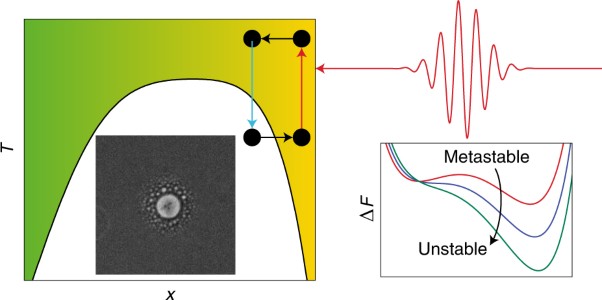 |
 |
 |
 |
| Single helically folded aromatic oligoamides that mimic the charge surface of double-stranded B-DNA pp511 - 518
Krzysztof Ziach, Céline Chollet, Vincent Parissi, Panchami Prabhakaran, Mathieu Marchivie et al.
doi:10.1038/s41557-018-0018-7
Molecules that mimic the charge surface of B-DNA could enable the inhibition of DNA processive enzymes. Now, helically folded aromatic oligoamide scaffolds have been synthesized that display anions at positions similar to that of B-DNA phosphates. These foldamer mimics can recognize some DNA binding proteins and inhibit enzymes such as HIV integrase and topoisomerase 1. 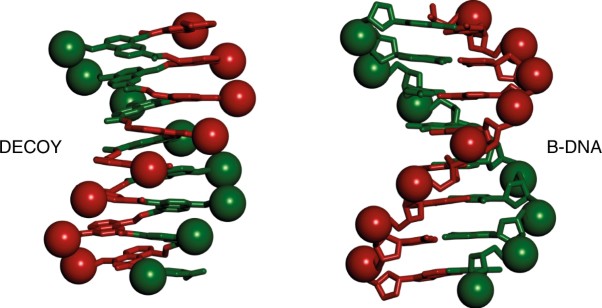 |
 |
 |
 |
| Understanding the quantum nature of low-energy C(3P j ) + He inelastic collisions pp519 - 522
Astrid Bergeat, Simon Chefdeville, Michel Costes, Sébastien B. Morales, Christian Naulin et al.
doi:10.1038/s41557-018-0030-y
Collision-induced spin–orbit transitions involve multiple interaction potentials and are by nature non-adiabatic, complicating both their experimental and theoretical study. Crossed-beam experiments and non-Born–Oppenheimer quantum calculations for inelastic collisions of carbon atoms with helium atoms, down to energies corresponding to temperatures below 10 K, have now been performed. Quantum-dynamical resonances predicted by theory were experimentally detected. 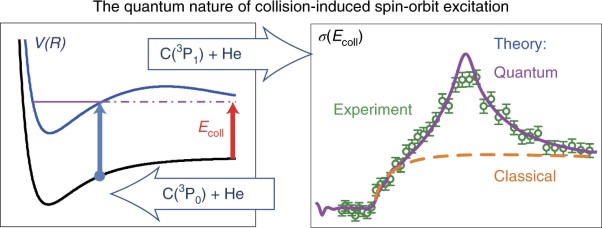 |
 |
 |
 |
| Distinct thermodynamic signatures of oligomer generation in the aggregation of the amyloid-β peptide pp523 - 531
Samuel I. A. Cohen, Risto Cukalevski, Thomas C. T. Michaels, Anđela Šarić, Mattias Törnquist et al.
doi:10.1038/s41557-018-0023-x
Mapping energy landscapes has proved to be a powerful approach for studying reaction mechanisms. Now, this strategy has been applied to determine the activation energies and entropies that characterize the molecular steps in the misfolding and aggregation of the amyloid-β peptide, revealing striking differences between the thermodynamic signatures of primary and secondary nucleation. 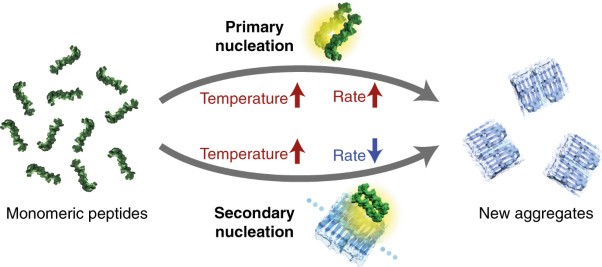 |
 |
 |
 |
| An artificial interphase enables reversible magnesium chemistry in carbonate electrolytes pp532 - 539
Seoung-Bum Son, Tao Gao, Steve P. Harvey, K. Xerxes Steirer, Adam Stokes et al.
doi:10.1038/s41557-018-0019-6
Mg-based batteries possess potential advantages over their lithium counterparts; however, the use of reversible oxidation-resistant, carbonate-based electrolytes has been hindered because of their undesirable electrochemical reduction reactions. Now, by engineering a Mg2+-conductive artificial interphase on a Mg electrode surface, which prevents such reactivity, highly reversible Mg deposition/stripping in carbonate-based electrolytes has been demonstrated. 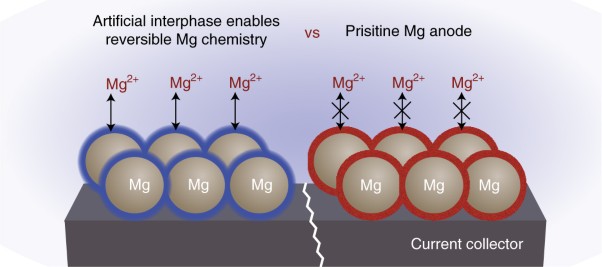 |
 |
 |
 |
| A general strategy for synthesis of cyclophane-braced peptide macrocycles via palladium-catalysed intramolecular sp3 C−H arylation pp540 - 548
Xuekai Zhang, Gang Lu, Meng Sun, Madhu Mahankali, Yanfei Ma et al.
doi:10.1038/s41557-018-0006-y
Peptide macrocycles are uniquely suited to engage some challenging biological targets, such as protein–protein interactions. Inspired by the ‘C–H’ cross-linked peptide natural products, a highly efficient and generally applicable strategy for constructing cyclophane-braced peptide macrocycles has been developed. The strategy is based on palladium-catalysed intramolecular C(sp3)–H arylation reactions. 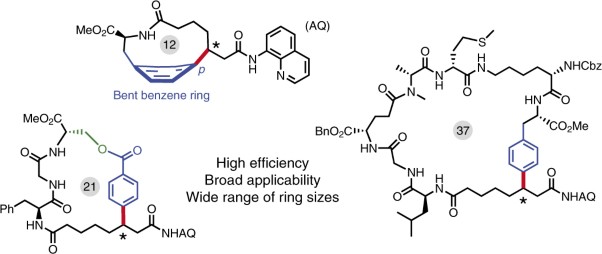 |
 |
 |
 |
| O2−O2 and O2−N2 collision-induced absorption mechanisms unravelled pp549 - 554
Tijs Karman, Mark A. J. Koenis, Agniva Banerjee, David H. Parker, Iouli E. Gordon et al.
doi:10.1038/s41557-018-0015-x
Molecular collisions can lead to the absorption of incident light even for transitions that are spectroscopically forbidden for the isolated molecules. Now the electronic–vibrational transitions of O2 have been theoretically studied and, contrary to textbook knowledge, it is shown that the absorption mechanism and the spectral line shape depend on the collision partner, oxygen or nitrogen. 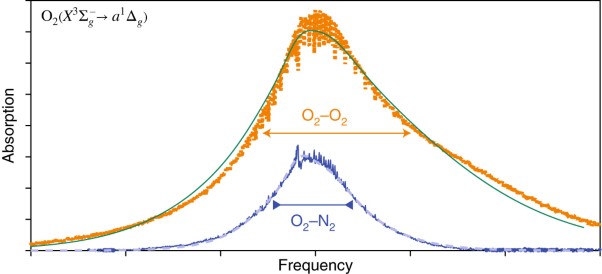 |
 |
 |
 |
| A [4Fe–4S]-Fe(CO)(CN)-l-cysteine intermediate is the first organometallic precursor in [FeFe] hydrogenase H-cluster bioassembly pp555 - 560
Guodong Rao, Lizhi Tao, Daniel L. M. Suess & R. David Britt
doi:10.1038/s41557-018-0026-7
The biosynthesis of the [FeFe] hydrogenase active site H-cluster requires several Fe–S proteins that perform poorly understood reactions. Now, a reaction intermediate trapped in the enzyme HydG is shown to contain a [(Cys)Fe(CO)(CN)] species identified as the first organometallic Fe moiety en route to the catalytic H-cluster. 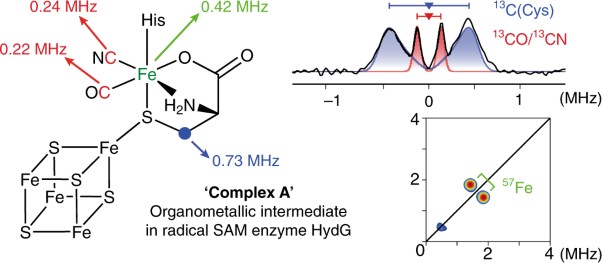 |
 |
 |
 |
| Cold quantum-controlled rotationally inelastic scattering of HD with H2 and D2 reveals collisional partner reorientation pp561 - 567
William E. Perreault, Nandini Mukherjee & Richard N. Zare
doi:10.1038/s41557-018-0028-5
Scattering of molecules at low temperature that are prepared in single quantum states illuminates the mechanism of rotationally inelastic collisions and reveals the reorientation of partner molecules. By correlating each outgoing partial wave with the incoming waves, partial-wave analysis of the scattering angular distribution determines the dominant short- and long-range anisotropies of the interaction potential. 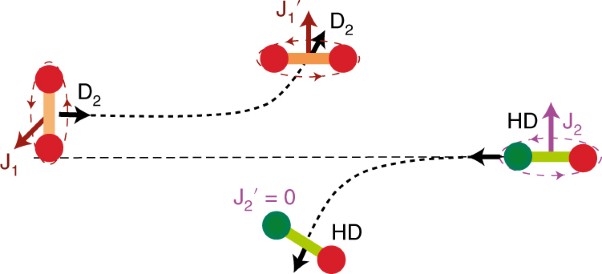 |
 |
 |
 |
| Tracing the ‘ninth sulfur’ of the nitrogenase cofactor via a semi-synthetic approach pp568 - 572
Kazuki Tanifuji, Chi Chung Lee, Nathaniel S. Sickerman, Kazuyuki Tatsumi, Yasuhiro Ohki et al.
doi:10.1038/s41557-018-0029-4
The M-cluster in the active site of nitrogenase is derived from an 8Fe core assembled via coupling and rearrangement of two [Fe4S4] clusters concomitant with the insertion of an interstitial carbon and a ninth sulfur. Now, by combining synthetic [Fe4S4] clusters and assembly with a protein template, it has been shown that sulfite gives rise to the ninth sulfur that is inserted into the nitrogenase cofactor after the radical SAM-dependent carbide insertion and cofactor core rearrangement. 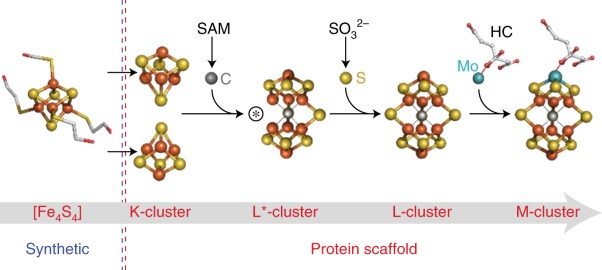 |
 |
 |
 |
Amendments & Corrections | |
 |
 |
 |
| Publisher Correction: O2−O2 and O2−N2 collision-induced absorption mechanisms unravelled p573
Tijs Karman, Mark A. J. Koenis, Agniva Banerjee, David H. Parker, Iouli E. Gordon et al.
doi:10.1038/s41557-018-0063-2 |
 |
 |
 |
| Retraction Note: Catalytic living ring-opening metathesis polymerization p573
Amit A. Nagarkar & Andreas F. M. Kilbinger
doi:10.1038/s41557-018-0044-5 |
 |
In Your Element | |
 |
 |
 |
| Praseodymium unpaired p576
Adrian Dingle
doi:10.1038/s41557-018-0050-7 |
 |
 |  |  |  |  |  | Natureevents is a fully searchable, multi-disciplinary database designed to maximise exposure for events organisers. The contents of the Natureevents Directory are now live. The digital version is available here.
Find the latest scientific conferences, courses, meetings and symposia on natureevents.com. For event advertising opportunities across the Nature Publishing Group portfolio please contact natureevents@nature.com |  |  |  |  |  | |
 |


No comments:
Post a Comment